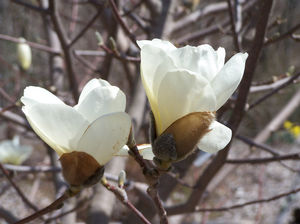View All Plants :: View All TREES
Magnolia denudata
Yulan Magnolia
Plant Type:
TREESMagnolia denudata – This is the Yulan Magnolia. Early blooming, the ivory 5” to 6” wide goblets composed of 9 to 12 petals emit a heavenly sweet fragrance. Some years they open with a bit more cream in the tepals but this slight variation in no way detracts from the extraordinary beauty of this tree. M. denudata is one of the parents used in breeding the yellow flowering cultivars when crossed with M. acuminata, the Cucumbertree Magnolia. The Yulan Magnolia embodies much history as it is probably the oldest cultivated ornamental tree; writings tell that it was planted around ancient Buddhist temples. The foliage usually turns a comely gold to golden brown here. It does occasionally fruit for us with pods splitting to display bright red seed. Winter wood is a light silvery brown. Yulan magnolia is difficult to produce from cuttings; therefore, we may be lucky enough to successfully root but a few and maybe not every year. Plant in fertile, moisture retaining soil and site in part to full sun. Spring planting is strongly urged in the north.
Characteristics and Attributes for Magnolia denudata
Season of Interest (Flowering)
- Spring
Season of Interest (Foliage)
- Spring / Summer / Autumn
Interesting Bark
- Smooth
Autumn Interest
- Fruit / Berries / Seed Heads
- Autumn Leaf Color
- Showy Buds
Nature Attraction
- Deer Resistant
Light
- Mostly Sunny
- Full Sun
Attributes
- Fragrant
- Specimen
- Alee
Growth Rate in the Garden
- Moderately Fast
Soil
- Fertile
- Organic
- Moist
Origins
- China
Propagated By
- Cutting Grown
Genus Overview: Magnolia
Common Name: Magnolia
The Magnolias are one of the earliest known flowering plants to establish themselves on our beautiful planet. Much breeding continues and the cultivar list is expanding with some smaller sizes and new flower colors. Many are typical tree forms while some tend to be multi-stemmed – more like huge shrubs than single-stemmed trees. Most are spring blooming – some early, others later after danger of frost has passed in the north. A few of these will provide some recurrence of bloom during the summer. A handful bloom in summer. Many emit wonderful fragrance. The foliage is often large, bold and paddle-shaped, looking attractive in summer; a handful of species’ leaves are so large that they are reminiscent of banana foliage. Some seasons they develop gold to golden brown autumn color before the leaves drop. It’s hard for me to think of a landscape without one or more included in the mix. All prefer fertile deep loam with plenty of organic matter and moist soils – some are even content in relatively wet conditions. Magnolias should be sited in full to half sun exposures. All our selections are cutting grown, on their own wood – they are not grafted. Some are much easier to produce on their own wood than others; some are quite recalcitrant. In that, we may not always have certain plants available or available in great numbers. Spring planting is recommended for magnolias especially up north. Cutting grown.


